How to Ferret-Proof Your Home for Free Roaming Time
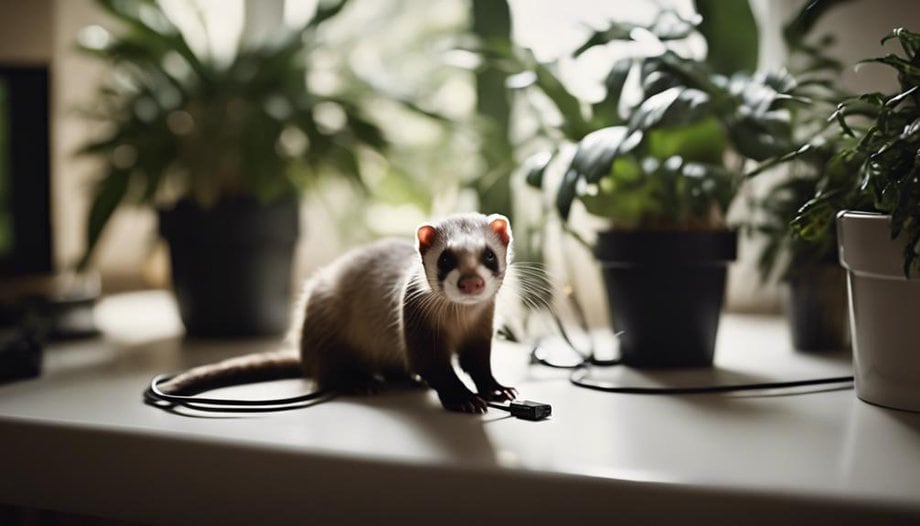
Ferrets are curious and playful animals that require a safe environment for free-roaming time. Here are some essential tips to ferret-proof your home:
- Remove any toxic plants, chemicals, and small objects that could be swallowed.
- Block off any small spaces where a ferret could get stuck or hide.
- Cover any exposed electrical cords to prevent chewing.
- Keep the toilet lid closed to prevent drowning accidents.
- Secure any heavy furniture or appliances that could fall over.
- Supervise your ferret at all times to prevent accidents and ensure their safety.
By following these tips, you can create a safe and enjoyable environment for your ferret to explore during free-roaming time.
Assessing Potential Hazards
When assessing potential hazards for ferret-proofing your home, it's crucial to thoroughly inspect each room and identify any small spaces or gaps that could pose a risk to your pet. One essential step is rearranging furniture to create safe play areas for your ferret. Ensure that there are no gaps behind or beneath heavy furniture where your pet could get stuck or hide.
Additionally, consider setting up an indoor playground with tunnels, boxes, and safe toys to keep your ferret entertained and prevent them from exploring hazardous areas.
Moreover, it's vital to establish emergency escape routes in case your ferret accidentally gets into a dangerous situation. Keep pathways clear and avoid clutter that could impede your pet's movement during an emergency. By proactively addressing these potential hazards and creating secure play spaces, you can significantly reduce the risks and enhance the safety of your home for your beloved ferret.
Securing Electrical Outlets
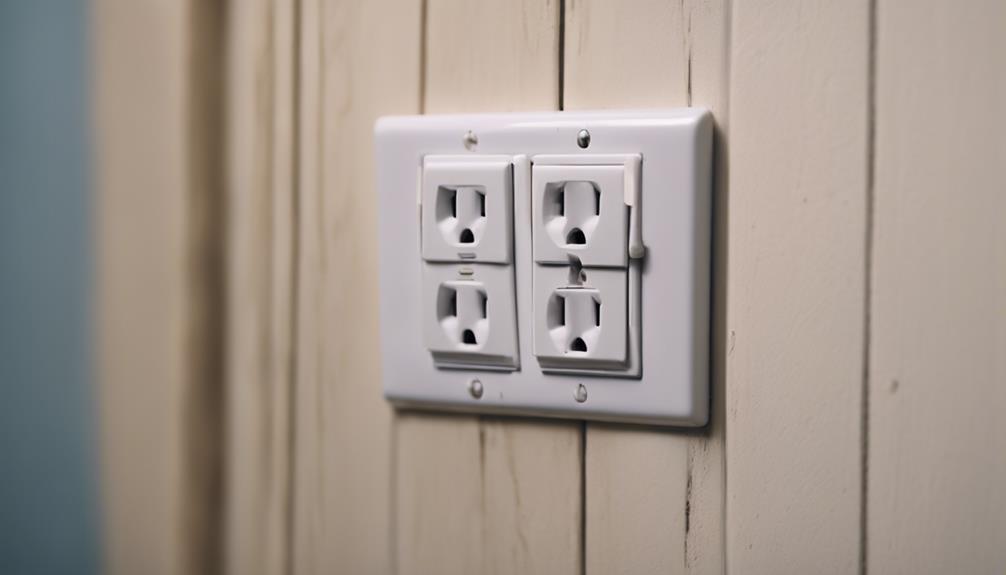
To ensure the safety of your ferret, it's essential to properly secure electrical outlets throughout your home. Ferrets are naturally curious creatures, and exposed outlets pose significant electrical hazards. One of the most effective ways to protect your furry friend is by using outlet covers. These covers act as a barrier between your ferret and the electrical components, preventing potential shocks or burns.
When childproofing your home for a ferret, consider applying similar safety precautions as you'd for a toddler. Childproofing techniques such as securing outlets not only safeguard your ferret but also create a secure environment for everyone in the household. By investing in outlet covers and implementing childproofing measures, you can minimize the risk of accidents and ensure a safe space for your free-roaming ferret.
Blocking Small Spaces
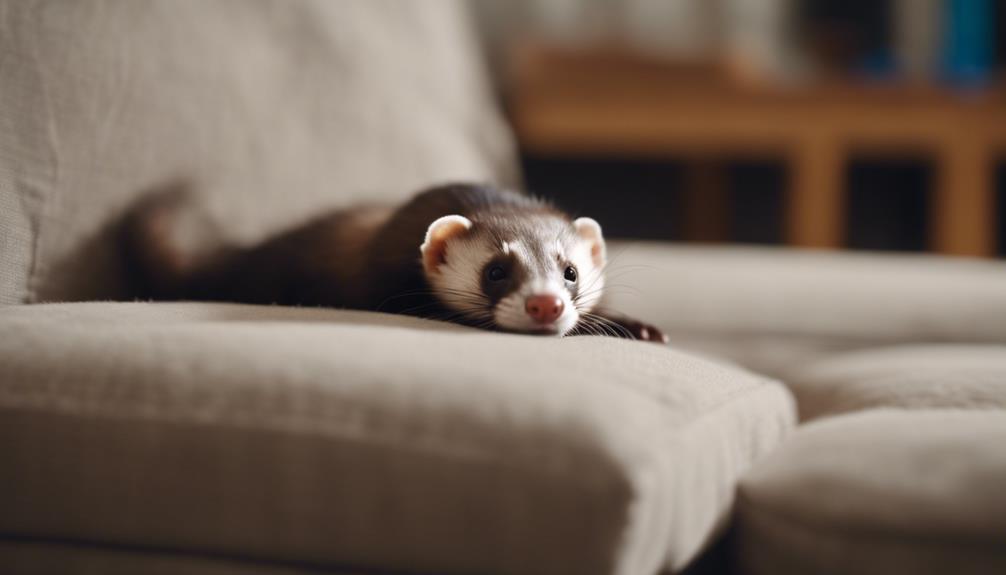
To prevent ferrets from accessing small spaces in your home, it's crucial to cover gaps under furniture to prevent them from squeezing through.
Securing loose wires is essential to avoid potential hazards and to prevent ferrets from getting tangled.
Installing door barriers can help restrict access to certain areas and keep ferrets safe and contained within designated spaces.
Covering Gaps Under Furniture
Covering gaps under furniture is essential to prevent ferrets from accessing small spaces where they may get stuck or hide. Gap prevention is crucial for ensuring the safety of your furry companions during their free-roaming time.
To achieve effective furniture protection, start by inspecting all furniture pieces for any openings or crevices that a curious ferret could squeeze into. Use materials like cardboard, wooden boards, or foam to block off these gaps securely. Pay special attention to areas where multiple furniture pieces meet, as these junctions often create hidden openings.
Regularly check and reinforce these coverings to maintain a secure environment for your ferrets. By diligently covering gaps under furniture, you can create a safer space for your playful pets to explore without any worries.
Securing Loose Wires
Inspecting loose wires and securing them is crucial for blocking small spaces that ferrets may try to access in your home. Ferrets are curious creatures that can easily squeeze through tight openings in search of exploration. To ensure their safety and prevent any accidents related to wire management, follow these tips:
- Bundle cables: Use cable ties or cord organizers to group wires together and prevent them from dangling or spreading out.
- Hide wires: Conceal cables behind furniture or use cable management sleeves to keep them out of reach.
- Secure wires: Use tape or cable clips to affix wires along the baseboards or walls, making them less accessible to ferrets.
Installing Door Barriers
When securing your home against small spaces that ferrets may access, consider installing door barriers as a preventative measure. Door barricades are essential safety measures to prevent your curious ferret from entering restricted areas or getting stuck in tight spaces. By pet proofing your home with DIY solutions like door barriers, you create a safer environment for your furry friend to roam freely. These barriers can be easily installed using common household items and require minimal effort. To help you get started, here is a simple guide on how to create your own door barriers:
| Materials Needed | Instructions |
|---|---|
| Wooden planks or baby gates | Measure the doorway width and cut the plank or gate to fit. |
| Screws and drill | Secure the plank or gate across the doorway using screws and a drill. |
| Optional: Plexiglass | Attach plexiglass to the bottom to prevent ferrets from squeezing through. |
Removing Toxic Plants
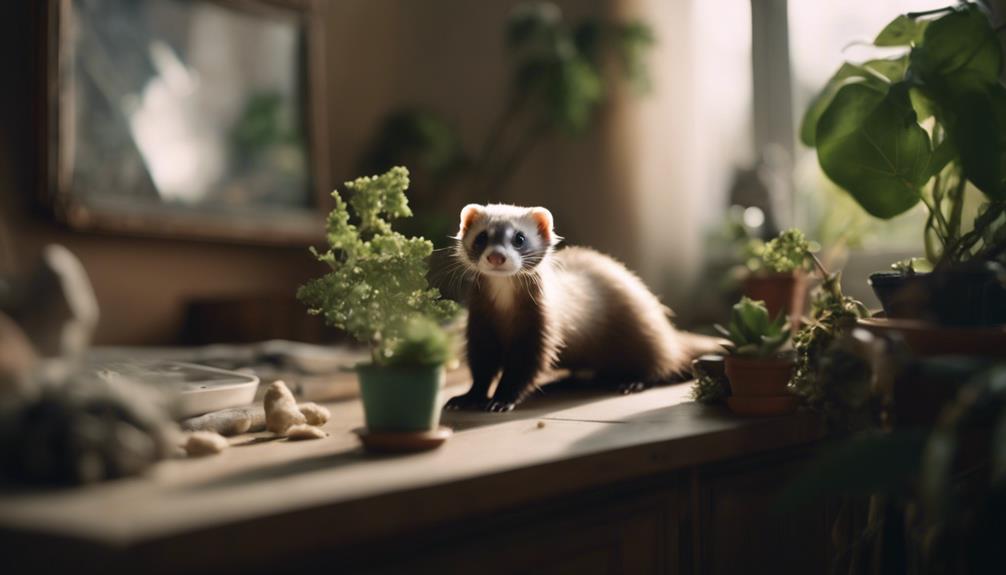
When it comes to keeping ferrets safe at home, it's essential to be mindful of the plants within reach. Some common houseplants can be toxic to ferrets if ingested, causing a range of health issues.
To ensure a ferret-friendly environment, pet owners should familiarize themselves with plant safety tips and consider non-toxic alternatives for their indoor greenery.
Plant Safety Tips
To ensure a safe environment for your ferret, it's essential to remove any toxic plants from your home. When it comes to plant safety tips for your furry friend, consider the following:
- Pet-Friendly Plants: Opt for pet-friendly indoor greenery to create a safe and natural environment for your ferret.
- Safe Greenery Choices: Choose safe greenery options that are non-toxic to ferrets to prevent any potential toxicity risks.
- Toxicity Risks: Be aware of plants that pose toxicity risks to your ferret and remove them promptly from your living space.
Non-Toxic Alternatives
Considering the safety of your ferret, it's imperative to swiftly replace any toxic plants in your home with non-toxic alternatives.
Toxic plants such as lilies, philodendrons, and ivy can pose a severe risk to your ferret's health if ingested. Replace these with safe options like spider plants, African violets, or bamboo palm.
Additionally, creating DIY deterrents like placing double-sided tape around plant pots can help discourage your ferret from exploring these potentially harmful areas.
Regularly inspect your home for any toxic plants and promptly remove or replace them to ensure a safe environment for your furry friend. This simple step can significantly reduce the risk of accidental poisoning and promote a healthier living space for both you and your ferret.
Organizing Cables and Wires
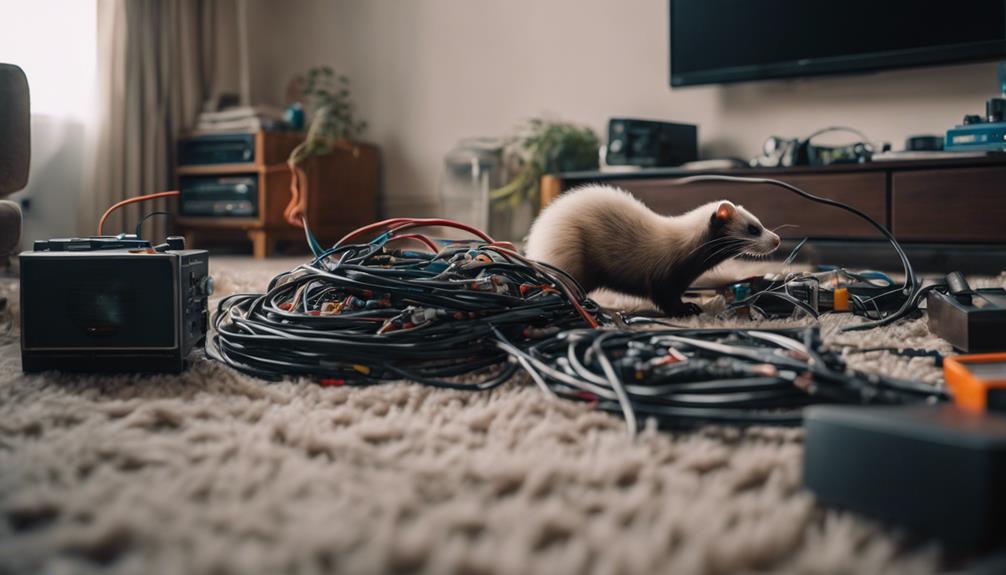
To prevent potential hazards and ensure a clutter-free environment, secure cables and wires in a safe and organized manner throughout your home. Here are some cable management and wire protection tips:
- Use Cable Organizers: Invest in cable organizers such as clips, ties, or sleeves to bundle and secure cables. This not only prevents your ferret from chewing on loose wires but also keeps them neatly organized.
- Elevate Cords: Keep cords out of your ferret's reach by elevating them off the ground or securing them along baseboards or walls. This minimizes the risk of entanglement and chewing.
- Hide Cables: Conceal cables behind furniture or in cable management boxes to prevent your ferret from accessing them. This strategy not only protects the wires but also maintains a tidy living space.
Safeguarding Furniture and Carpets
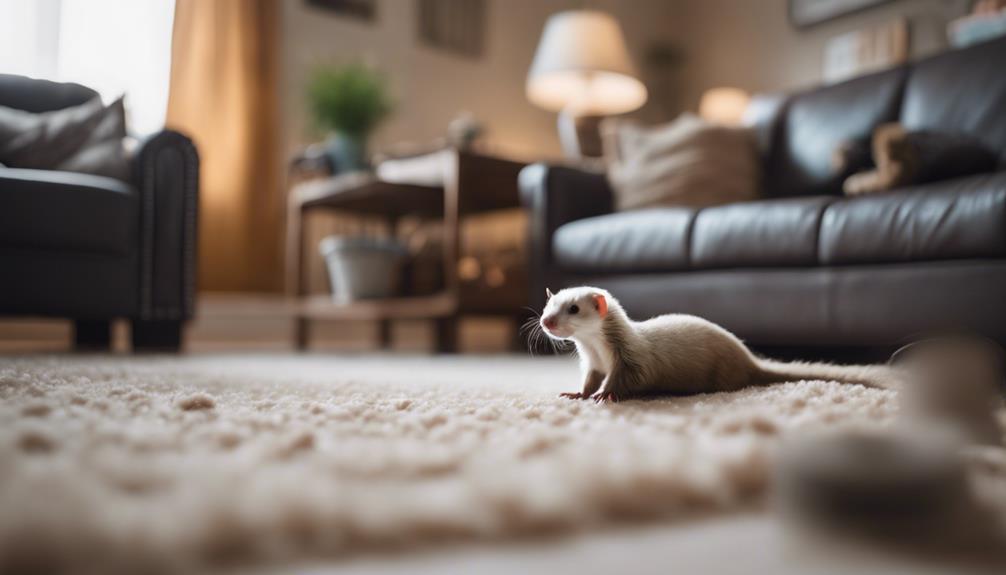
Securing furniture and carpets from potential damage caused by curious ferrets is essential for maintaining a safe and pristine living environment. To protect your belongings, consider implementing DIY solutions for furniture protection and prevention techniques for carpet care. Here are some practical tips to safeguard your furniture and carpets:
| Furniture Protection | DIY Solutions |
|---|---|
| Cover sharp edges with foam | Use double-sided tape to deter scratching |
| Secure loose items | Provide alternative chew toys |
| Avoid delicate fabrics | Apply bitter apple spray as a deterrent |
| Use pet-friendly materials | Create designated play areas |
For carpet care and prevention, regular vacuuming can help remove ferret hair and prevent odors. Additionally, placing rugs or mats in high-traffic areas can reduce wear and tear on carpets. It's also advisable to supervise your ferret during free-roaming time to ensure they do not cause any damage. By following these tips, you can enjoy a harmonious coexistence with your furry friends while keeping your furniture and carpets intact.
Monitoring Household Chemicals
Monitoring household chemicals is crucial for ensuring the safety and well-being of both your ferret and your household environment. Here are three essential tips to help you effectively manage household chemicals:
- Chemical Storage: Store all household chemicals in secure cabinets or high shelves out of your ferret's reach. Make sure the cabinets have child-proof latches or locks to prevent accidental access by your curious pet.
- Labeling Household Cleaners: Clearly label all household cleaners and chemicals. This not only helps you quickly identify each product but also ensures you use the right cleaner for the intended purpose, preventing any accidental exposure to harmful substances.
- Proper Disposal of Chemical Containers: After using household cleaners, ensure you securely close the containers and put them back in their designated storage area. Proper disposal of empty containers or old chemicals is crucial to prevent your ferret from coming into contact with any harmful residues.
Frequently Asked Questions
How Can I Train My Ferret to Avoid Certain Areas of the House?
To train a ferret to avoid certain areas, utilize training techniques like boundary reinforcement. Behavioral modification can help by redirecting instincts. Consistency and positive reinforcement play key roles in teaching your ferret to respect boundaries.
Are There Any Specific Household Items That Ferrets Are Attracted to That I Should Be Extra Cautious About?
Ferrets are naturally drawn to food attractants like sweets and meats, so owners should be cautious with leaving these items accessible. Additionally, ferrets are curious creatures and may investigate electrical hazards, posing a danger.
What Should I Do if My Ferret Has a History of Chewing on Furniture or Carpets?
When dealing with a ferret that has a history of chewing on furniture or carpets, it's essential to address this behavior promptly. Utilize deterrent options like bitter apple spray, along with positive reinforcement training methods and providing ample chew toys.
Can Ferrets Climb on Furniture or Curtains, and How Can I Prevent Them From Doing So?
Ferrets are agile climbers and may scale furniture or curtains. To prevent this, provide climbing toys and use deterrents like double-sided tape or citrus sprays. Training methods can establish playtime boundaries and redirect their behavior effectively.
How Often Should I Reassess and Update My Ferret-Proofing Measures in the Home?
Regular evaluation of ferret-proofing measures is crucial. It ensures a safe environment for your furry friend. Consistent reinforcement of boundaries and updates as needed keep your home secure. This ongoing process guarantees a happy and secure space for your pet.











